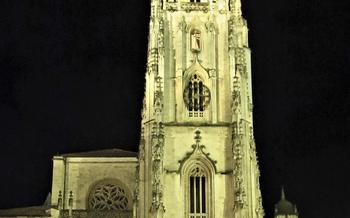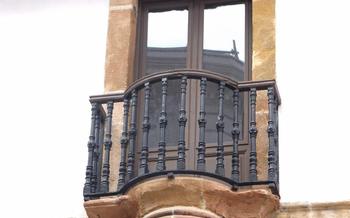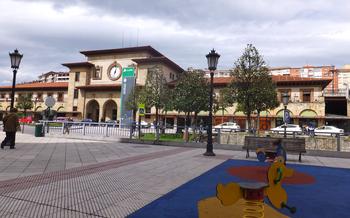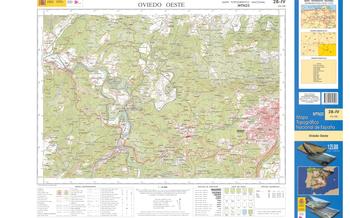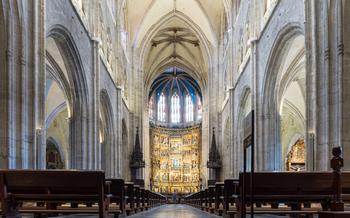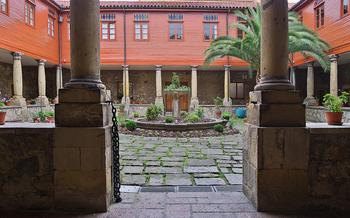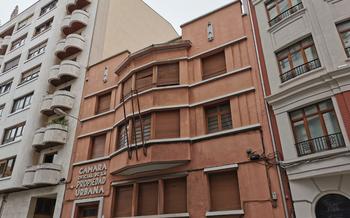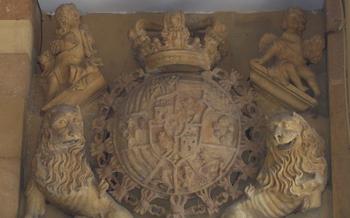
Ruta del Alba
- Oviedo's Captivating Charm
- Ruta del Alba: A Journey of Art and History
- San Julián de los Prados: A Masterpiece of Asturian Architecture
- San Julián de los Prados, a church with a captivating history, stands as a testament to the architectural prowess of the Asturian kingdom. Built in the 9th century, this pre-Romanesque marvel boasts a unique blend of artistic influences, blending elements of Visigothic, Roman, and Byzantine styles. Its distinctive horseshoe arches, reminiscent of Islamic architecture, add to its allure.
- The church's interior is adorned with intricate carvings and well-preserved frescoes, showcasing the artistic talents of the Asturian craftsmen. The frescoes, depicting biblical scenes and figures, offer a glimpse into the religious beliefs and iconography of the period. San Julián de los Prados holds immense historical significance, earning its place as a UNESCO World Heritage Site, recognizing its exceptional cultural and architectural value. Its enduring legacy as a masterpiece of Asturian architecture continues to inspire and captivate visitors, making it a must-see destination for anyone exploring Oviedo's rich heritage.
- Practical Information:
- Santa María del Naranco: A Regal Palace with Stunning Views
- San Miguel de Lillo: A Hidden Gem of Asturian Art
- Plaza de la Catedral: The Heart of Oviedo's Religious Heritage
- Cider Tasting: A Culinary Adventure in Asturias
- Mercado El Fontán: A Culinary Market with Local Delights
- Oviedo Cathedral: A Gothic Masterpiece with Holy Relics
- Plaza del Ayuntamiento: The Civic Center of Oviedo
- Museo de Bellas Artes de Asturias: A Treasure Trove of Asturian Art
- Monte Naranco: A Scenic Escape with Stunning City Views
- Insider Tip: The Best Time to Visit Oviedo
Oviedo's Captivating Charm
Oviedo, the capital of Asturias, is a city of captivating charm, where history intertwines with modernity, and nature's beauty blends seamlessly with urban life. Its ancient roots date back to the 8th century, when it served as the capital of the Asturian kingdom. Over the centuries, Oviedo has evolved into a vibrant and cosmopolitan city, while still retaining its rich heritage and traditions.
The city's diverse attractions cater to every taste and interest. From its mouthwatering gastronomy, featuring local delicacies like fabada and cachopo, to its stunning natural surroundings, with lush forests and pristine beaches just a short drive away, Oviedo offers a unique and unforgettable experience.
The people of Oviedo are renowned for their warmth and hospitality, welcoming visitors with open arms and a genuine desire to share their culture and traditions. The city's layout is compact and easy to navigate, with key neighborhoods like the old town and the modern business district within walking distance of each other.
Whether you're a history buff, a nature lover, or simply seeking a charming and authentic Spanish experience, Oviedo is a city that will capture your heart and leave you with lasting memories.
Ruta del Alba: A Journey of Art and History
In the heart of Oviedo lies the enchanting Ruta del Alba, a cultural route that takes you on a journey through time, showcasing the city's rich artistic and historical heritage. This carefully curated path weaves together Oviedo's most significant landmarks, inviting you to discover the stories and secrets behind each architectural masterpiece.
As you embark on the Ruta del Alba, you'll encounter a diverse array of landmarks, from ancient churches to stately palaces, each with its own unique tale to tell. These monuments stand as testaments to Oviedo's glorious past, a time when kings and queens ruled, and art and architecture flourished.
The route begins at the iconic San Julián de los Prados, a pre-Romanesque church that has stood the test of time, its intricate carvings and well-preserved frescoes whispering tales of a bygone era. From there, you'll wander through the picturesque streets of Oviedo, passing by the majestic Santa María del Naranco, a former royal palace that exudes elegance and power.
As you delve deeper into the Ruta del Alba, you'll discover hidden gems like San Miguel de Lillo, a small yet exquisite church that captivates with its harmonious proportions and stunning frescoes. The route also takes you through the tranquil Campo de San Francisco, a verdant oasis in the city center, where you can escape the hustle and bustle and soak in the serene beauty of nature.
Following the Ruta del Alba is an immersive experience that allows you to appreciate Oviedo's architectural treasures and gain a deeper understanding of the city's rich history. Whether you're an art enthusiast, a history buff, or simply a curious traveler, this cultural route promises an unforgettable journey through the heart and soul of Oviedo.
San Julián de los Prados: A Masterpiece of Asturian Architecture
San Julián de los Prados, a church with a captivating history, stands as a testament to the architectural prowess of the Asturian kingdom. Built in the 9th century, this pre-Romanesque marvel boasts a unique blend of artistic influences, blending elements of Visigothic, Roman, and Byzantine styles. Its distinctive horseshoe arches, reminiscent of Islamic architecture, add to its allure.
The church's interior is adorned with intricate carvings and well-preserved frescoes, showcasing the artistic talents of the Asturian craftsmen. The frescoes, depicting biblical scenes and figures, offer a glimpse into the religious beliefs and iconography of the period. San Julián de los Prados holds immense historical significance, earning its place as a UNESCO World Heritage Site, recognizing its exceptional cultural and architectural value. Its enduring legacy as a masterpiece of Asturian architecture continues to inspire and captivate visitors, making it a must-see destination for anyone exploring Oviedo's rich heritage.
Practical Information:
- Opening Hours: Tuesday to Sunday, 10 am - 1 pm and 3:30 pm - 6:30 pm.
- Admission Fee: Free entry.
- Guided Tours: Available upon request. Check with the local tourist office for details.
Santa María del Naranco: A Regal Palace with Stunning Views
Santa María stands as a testament to the architectural prowess and grandeur of the Asturian kingdom. This two-story palace, with its intricate carvings and stunning views over the city, is a must-see attraction for any visitor to Oviedo.
Originally constructed as a royal residence, Santa María del Naranco showcases the Asturian fondness for intricate stonework. Its elegant facade is adorned with blind arches, engaged columns, and a frieze featuring a procession of animals. The interior is equally impressive, with a large, open hall on the ground floor and a smaller, more private chamber on the upper floor.
Beyond its architectural beauty, Santa María del Naranco holds historical significance as a symbol of power and prestige during the Asturian kingdom. It was a place where kings and queens resided, hosted lavish banquets, and conducted important affairs of state. Its strategic location atop Monte Naranco provided a commanding view of the surrounding countryside, allowing the royals to keep a watchful eye over their domain.
Today, Santa María del Naranco stands as a beloved landmark and a UNESCO World Heritage Site. Visitors can explore its well-preserved interior, marvel at its intricate carvings, and soak in the stunning views from its upper floor. Guided tours are available, providing insights into the palace's history, architecture, and significance.
San Miguel de Lillo: A Hidden Gem of Asturian Art
Nestled near the more famous Santa María del Naranco, San Miguel de Lillo stands as a testament to the artistic and cultural achievements of the Asturian kingdom. This small yet significant pre-Romanesque church captivates with its harmonious proportions and intricate carvings that adorn its exterior and interior. The church's most striking feature is its series of well-preserved frescoes, which depict biblical scenes and figures with remarkable detail and expressiveness. San Miguel de Lillo's frescoes are considered among the finest examples of early medieval painting in Spain, offering a glimpse into the artistic and religious traditions of the time.
Despite its smaller size compared to its neighboring counterparts, San Miguel de Lillo holds its own in terms of historical and artistic significance. Its unique architectural features and stunning frescoes make it a must-visit destination for anyone interested in Asturian art and history. Visitors can explore the church's interior and admire the intricate carvings and paintings that have stood the test of time, gaining a deeper appreciation for the artistic legacy of the Asturian kingdom.
Plaza de la Catedral: The Heart of Oviedo's Religious Heritage
In the heart of Oviedo's old town, Plaza de la Catedral stands as a testament to the city's deep religious roots. Dominated by the imposing Oviedo Cathedral, the square is a captivating blend of architectural styles and historical significance.
The cathedral itself is a Gothic masterpiece, its intricate facade adorned with sculptures and gargoyles. Inside, visitors are awed by the soaring vaults, stained glass windows, and the intricate carvings of the choir stalls. The cathedral is also home to several holy relics, including the Sudarium of Oviedo, believed to be the cloth that covered Christ's face after his crucifixion.
Adjacent to the cathedral is the Gothic cloister, a serene oasis with delicate tracery and graceful arches. The cloister provides a tranquil retreat from the bustling square, inviting visitors to pause and reflect.
Completing the ensemble is the Archbishop's Palace, a Renaissance-style building that once housed the city's archbishop. Today, it serves as a museum, showcasing religious art and artifacts from Oviedo's past.
Plaza de la Catedral is a vibrant square, teeming with life throughout the day. Locals and tourists alike gather here to admire the architecture, soak up the atmosphere, and experience the city's rich religious heritage.
Cider Tasting: A Culinary Adventure in Asturias
In the heart of Asturias, cider is not just a drink; it's a cultural phenomenon. The region boasts a rich tradition of cider making that dates back centuries, and Oviedo is no exception. Here, you'll find numerous cider bars, or sidrerías, where you can sample the local brew and experience the unique Asturian cider culture.
Asturian cider, known as sidra, is a slightly tart and sparkling beverage made from fermented apple juice. It's typically served in a traditional glass called a "culín," which is filled to the brim and then poured from a height to create a frothy head. The pouring technique, known as "escanciado," is an art form in itself and adds to the overall cider experience.
When visiting Oviedo, be sure to explore the city's sidrerías and indulge in a glass of sidra. You'll find a wide variety of local ciders to choose from, each with its distinctive flavor and character. Whether you're a cider enthusiast or simply looking for a taste of Asturian culture, a cider tasting in Oviedo is an experience not to be missed.
Mercado El Fontán: A Culinary Market with Local Delights
In the heart of Oviedo's old town, Mercado El Fontán stands as a vibrant testament to Asturian gastronomy. A bustling hub of activity, the market offers a tantalizing array of fresh produce, seafood, and local delicacies, enticing visitors with its lively atmosphere and diverse range of stalls.
From traditional fishmongers displaying the day's catch to specialty cheese shops showcasing a variety of artisanal cheeses, Mercado El Fontán is a culinary paradise for food enthusiasts. The air is filled with the heady aroma of freshly baked bread, the sweet scent of ripe fruit, and the salty tang of cured meats, creating a sensory experience that is both delightful and overwhelming.
As you navigate the market's narrow aisles, be sure to sample some of the local specialties, such as cachopo, a breaded and fried steak sandwich, or fabada, a hearty bean stew. Don't miss the opportunity to indulge in a glass of Asturian cider, a slightly tart and refreshing beverage that is poured from a height to create a foamy head.
Mercado El Fontán is not just a place to shop for food; it's also a place to experience the local culture. Engage with the friendly vendors, who are always happy to share their knowledge about Asturian cuisine and recommend the best products.
Whether you're a foodie looking for fresh ingredients or a traveler seeking a taste of authentic Asturian culture, Mercado El Fontán is a must-visit destination in Oviedo.
Oviedo Cathedral: A Gothic Masterpiece with Holy Relics
Oviedo Cathedral, a magnificent edifice of Gothic grandeur, stands as a testament to the city's deep-rooted faith and rich history. Its stunning facade, adorned with intricate carvings and delicate tracery, beckons visitors to step into a realm of spiritual wonder. Inside, the soaring vaults, graceful columns, and stained-glass windows create an atmosphere of awe and reverence.
Beyond its architectural splendor, Oviedo Cathedral holds a profound religious significance. It is home to several revered relics, including the Sudarium of Oviedo, believed to be the cloth that covered the head of Jesus Christ during his crucifixion. This sacred artifact attracts pilgrims from around the world, who come to pay homage and seek divine blessings.
Whether you're a devout Catholic or simply an admirer of architectural masterpieces, Oviedo Cathedral is a must-visit destination. Its Gothic beauty, coupled with the presence of holy relics, makes it a place of profound spiritual and cultural importance. Don't miss the opportunity to explore this sacred space and immerse yourself in the rich history and religious traditions of Oviedo.
Plaza del Ayuntamiento: The Civic Center of Oviedo
In the heart of Oviedo, where the city's pulse beats, lies Plaza del Ayuntamiento, an emblem of Oviedo's civic pride and historical significance. Anchored by the majestic Town Hall, a splendid Renaissance edifice, the square exudes an aura of authority and elegance. Its harmonious blend of architectural styles, from the Gothic to the Baroque, creates a captivating tapestry that transports visitors back in time.
The Town Hall, with its intricate carvings, ornate balconies, and imposing clock tower, stands as a testament to Oviedo's rich heritage. The square is further adorned with the statue of King Pelayo, the legendary founder of the Kingdom of Asturias, immortalized in bronze, gazing resolutely towards the future. Beneath the graceful arcades that line the square, visitors can find respite from the bustling city, enjoying a leisurely coffee or browsing the local shops.
Plaza del Ayuntamiento has witnessed countless events that have shaped Oviedo's history. From vibrant markets and lively festivals to solemn ceremonies and political rallies, the square has served as a stage for the city's triumphs and tribulations. Today, it remains a popular gathering place for locals and tourists alike, a place to celebrate, to debate, and to simply soak in the vibrant atmosphere of Oviedo.
Whether you're an architecture enthusiast, a history buff, or simply a curious traveler, Plaza del Ayuntamiento is a must-visit destination in Oviedo. Immerse yourself in the square's rich tapestry of history, admire its architectural wonders, and feel the pulse of the city as it unfolds before you.
Museo de Bellas Artes de Asturias: A Treasure Trove of Asturian Art
Nestled in the heart of Oviedo, the Museo de Bellas Artes de Asturias stands as a testament to the city's rich artistic heritage. This world-renowned museum houses a diverse collection of over 15,000 artworks, spanning from the Middle Ages to the present day. Among its highlights are masterpieces by Spanish masters such as El Greco, Goya, and Dalí, as well as a significant collection of Asturian contemporary art.
Visitors to the museum are greeted by a stunning collection of medieval and Renaissance art, including religious paintings, sculptures, and altarpieces. The museum's collection of Spanish Golden Age art is particularly impressive, featuring works by some of the most renowned artists of the period. The museum also boasts a significant collection of Asturian art, showcasing the unique artistic traditions of the region.
In addition to its permanent collection, the Museo de Bellas Artes de Asturias regularly hosts temporary exhibitions, showcasing works from around the world. The museum also offers a variety of educational programs and workshops, making it a great place for visitors of all ages to learn about and appreciate art.
Whether you're an art enthusiast or simply looking for a place to escape the hustle and bustle of city life, the Museo de Bellas Artes de Asturias is a must-visit destination in Oviedo. With its world-class collection of art and its vibrant atmosphere, the museum is sure to leave a lasting impression.
Monte Naranco: A Scenic Escape with Stunning City Views
Monte Naranco is a hill located on the outskirts of Oviedo that offers breathtaking panoramic views of the city and the surrounding countryside. Its natural beauty, including lush forests, rolling hills, and scenic trails, makes it a popular destination for locals and tourists alike. The hill's historical significance adds to its charm, as it was once the site of ancient settlements and a strategic location for defending the city.
Whether you're an avid hiker looking to explore the great outdoors or simply seeking a peaceful escape from the hustle and bustle of city life, Monte Naranco has something to offer everyone. The hill's well-maintained trails wind through dense forests, leading to scenic viewpoints that provide stunning vistas of Oviedo and the surrounding countryside. Along the way, you'll encounter a variety of flora and fauna, including wildflowers, birds, and even the occasional deer.
In addition to its natural beauty, Monte Naranco is also home to several historical sites, including the remains of ancient settlements and fortifications. The hilltop was once the site of a castro, a type of fortified settlement common in northwestern Spain during the Iron Age. Later, the hill was used as a strategic military location by the Romans and the Visigoths. Remnants of these past civilizations can still be seen today, adding a touch of history to your hike.
To reach Monte Naranco, you can take a leisurely walk or bike ride from the city center, following the signs that lead to the hill. Alternatively, you can take a bus or taxi to the base of the hill and start your hike from there. Once you reach the top, you'll be rewarded with breathtaking views that will make your effort worthwhile.
Insider Tip: The Best Time to Visit Oviedo
Oviedo is a year-round destination, but the best time to visit is during the shoulder seasons (spring and autumn) when the weather is pleasant and the crowds are smaller. Spring (April-May) offers mild temperatures and a burst of color as the city's parks and gardens come to life. Autumn (September-October) is equally delightful, with crisp air, vibrant fall foliage, and fewer tourists. Summer (June-August) can be hot and crowded, but it's also the time for lively festivals and outdoor events. Winter (November-March) is generally mild, but some attractions may have reduced hours or be closed altogether. No matter when you choose to visit, Oviedo's charm and hospitality will make your stay memorable.
